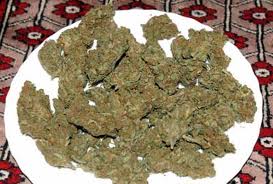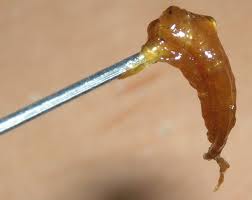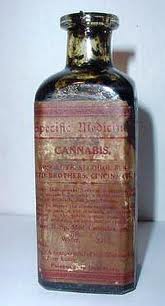BBC
Health
A guide to cannabis, how it is used, how it works and what the risks are.
Dr Trisha Macnair last medically reviewed this article in March 2010.
Cannabis is a drug produced from the Cannabis sativa (commonly known as hemp) or Cannabis indica plant, which is related to nettles and hops. It's believed to have originated in the mountainous regions of India, and grows wild in many parts of the world.
The plant contains more than 400 chemicals, including cannabidiolic acid, an antibiotic with similar properties to penicillin. The different chemical derivatives of the plant can be used for medicinal or recreational purposes.
The recreational drug cannabis comes in many forms – herbal (dried plant material), resin, powder, hash, tinctures and oil - and is known by many slang terms, including weed, pot, mary jane, grass, ganja, reefer, marijuana and hash, among others.
Dried Plant Material


Resin


Powder/ Kief


Kief Hash

Oil/ Ear Wax


Tincture/ Extract


Effects and uses of cannabis
Cannabis is most widely used as a illegal street drug for its relaxing properties. It is usually rolled into a cigarette known as a joint, but can also be smoked in a pipe, brewed as a tea or mixed with food.
The main active ingredient in cannabis is tetrahydrocannabino (THC). One type, skunk, can be particularly potent as it contains two to three time as much THC as other types.
Cannabis acts as a mild sedative, leaving most people feeling relaxed, chilled out or just sleepy. It also:
Has mild hallucinogenic effects, causing a distortion of reality
Makes some people become more animated
Releases inhibitions, making people talkative or giggly
Can cause nausea in some people (despite the fact that cannabis can have an anti-nausea effect), while it quite often makes others feel hungry
Cannabis or its derivatives may also be used as a medical treatment. There is some scientific evidence to suggest it may be useful in a wide range of conditions. But the complex nature of the substances contained within the plant makes it difficult for medical research to establish clearly its safety or efficacy, so its effects are far from proven or well-understood. The active chemicals within cannabis (known as a group as cannabinoids) are gradually being identified and wide-scale trials testing the safety and efficacy of these cannabis extracts (or synthetic forms of them) are currently underway in the UK and elsewhere.
For instance, cannabis appears to be able to help reduce the side effects of chemotherapy treatment, although not more so than other already established medications. The drugs used to treat cancer are among the most powerful, and most toxic, used in medicine. They produce unpleasant side effects, such as days or weeks of vomiting and nausea after each treatment. Some cannabinoids relieve nausea and allow patients to eat and live normally.
Extracts also seem to benefit patients suffering from multiple sclerosis, although most of the benefit seems to be from people feeling more relaxed when taking a cannabinoid or medical derivative of cannabis. Recent research showed no reduction in muscle spasticity.
Claims have also been made for its use in treating:
Migraine
Headaches
Asthma
Strokes
Parkinson's disease
Alzheimer's disease
Alcoholism
Insomnia
Risks of cannabis
There's increasing evidence that cannabis use is linked to a number of health risks. It damages the ability to concentrate, decreases motivation and more than occasional use in teenagers can affect psychological development. Users can become anxious, suspicious and even paranoid. Heavy use increases the risk of serious psychiatric illness.
Users of skunk, a stronger and increasingly more available form of cannabis, are seven times more likely to develop a psychotic illness, such as schizophrenia, than people not using cannabis or using the more traditional forms. Cannabis also interferes with coordination, causing problems with balance, walking and driving.
There are other side effects of the drug, but they vary considerably and are less predictable, partly because cannabis has more than 400 active ingredients. They may include effects on the heart, such as increased heart rate and blood pressure, and damage to fertility. People who smoke cannabis are also exposed to the toxic chemicals in tobacco smoke.
People may become dependent on cannabis and find it difficult to stop using it, experiencing unpleasant withdrawal symptoms if they do stop such as cravings, agitation, mood changes, sleep problems, appetite disturbance and other symptoms.
The debate over the use of cannabis in medicine is highly controversial and emotive. Supporters of the drug claim it has wide-ranging benefits, but opponents say it is a potentially dangerous substance that can actually damage health.
Cannabis and the law
The use of cannabis remains illegal (except for prescribed cannabinoids as described above). It is a Class B drug. As a result, the penalties for getting caught with cannabis, especially on repeated occasions, can be severe.
A report by the House of Lords Science and Technology Committee recommended the use of cannabis for medicinal purposes. However, the British Medical Association (BMA) did not give the report 100 per cent support and believes only cannabinoids - carefully identified chemical derivatives of the cannabis plant - should be used in medicine. TheGovernment says it will not consider legalising cannabis for medical use until clinical trials had been completed.
Advice and support
Occasional users of cannabis may be able to give it up, although they may find it harder to give up the general smoking habit. However, heavier users may need expert help to stop. Talk to your GP or local community drug agency or clinic.

 Resin
Resin

 Powder/ Kief
Powder/ Kief

 Kief Hash
Kief Hash
 Oil/ Ear Wax
Oil/ Ear Wax

 Tincture/ Extract
Tincture/ Extract

 Effects and uses of cannabis
Cannabis is most widely used as a illegal street drug for its relaxing properties. It is usually rolled into a cigarette known as a joint, but can also be smoked in a pipe, brewed as a tea or mixed with food.
The main active ingredient in cannabis is tetrahydrocannabino (THC). One type, skunk, can be particularly potent as it contains two to three time as much THC as other types.
Cannabis acts as a mild sedative, leaving most people feeling relaxed, chilled out or just sleepy. It also:
Has mild hallucinogenic effects, causing a distortion of reality
Makes some people become more animated
Releases inhibitions, making people talkative or giggly
Can cause nausea in some people (despite the fact that cannabis can have an anti-nausea effect), while it quite often makes others feel hungry
Cannabis or its derivatives may also be used as a medical treatment. There is some scientific evidence to suggest it may be useful in a wide range of conditions. But the complex nature of the substances contained within the plant makes it difficult for medical research to establish clearly its safety or efficacy, so its effects are far from proven or well-understood. The active chemicals within cannabis (known as a group as cannabinoids) are gradually being identified and wide-scale trials testing the safety and efficacy of these cannabis extracts (or synthetic forms of them) are currently underway in the UK and elsewhere.
For instance, cannabis appears to be able to help reduce the side effects of chemotherapy treatment, although not more so than other already established medications. The drugs used to treat cancer are among the most powerful, and most toxic, used in medicine. They produce unpleasant side effects, such as days or weeks of vomiting and nausea after each treatment. Some cannabinoids relieve nausea and allow patients to eat and live normally.
Extracts also seem to benefit patients suffering from multiple sclerosis, although most of the benefit seems to be from people feeling more relaxed when taking a cannabinoid or medical derivative of cannabis. Recent research showed no reduction in muscle spasticity.
Claims have also been made for its use in treating:
Migraine
Headaches
Asthma
Strokes
Parkinson's disease
Alzheimer's disease
Alcoholism
Insomnia
Risks of cannabis
There's increasing evidence that cannabis use is linked to a number of health risks. It damages the ability to concentrate, decreases motivation and more than occasional use in teenagers can affect psychological development. Users can become anxious, suspicious and even paranoid. Heavy use increases the risk of serious psychiatric illness.
Users of skunk, a stronger and increasingly more available form of cannabis, are seven times more likely to develop a psychotic illness, such as schizophrenia, than people not using cannabis or using the more traditional forms. Cannabis also interferes with coordination, causing problems with balance, walking and driving.
There are other side effects of the drug, but they vary considerably and are less predictable, partly because cannabis has more than 400 active ingredients. They may include effects on the heart, such as increased heart rate and blood pressure, and damage to fertility. People who smoke cannabis are also exposed to the toxic chemicals in tobacco smoke.
People may become dependent on cannabis and find it difficult to stop using it, experiencing unpleasant withdrawal symptoms if they do stop such as cravings, agitation, mood changes, sleep problems, appetite disturbance and other symptoms.
The debate over the use of cannabis in medicine is highly controversial and emotive. Supporters of the drug claim it has wide-ranging benefits, but opponents say it is a potentially dangerous substance that can actually damage health.
Cannabis and the law
The use of cannabis remains illegal (except for prescribed cannabinoids as described above). It is a Class B drug. As a result, the penalties for getting caught with cannabis, especially on repeated occasions, can be severe.
A report by the House of Lords Science and Technology Committee recommended the use of cannabis for medicinal purposes. However, the British Medical Association (BMA) did not give the report 100 per cent support and believes only cannabinoids - carefully identified chemical derivatives of the cannabis plant - should be used in medicine. TheGovernment says it will not consider legalising cannabis for medical use until clinical trials had been completed.
Advice and support
Occasional users of cannabis may be able to give it up, although they may find it harder to give up the general smoking habit. However, heavier users may need expert help to stop. Talk to your GP or local community drug agency or clinic.
Effects and uses of cannabis
Cannabis is most widely used as a illegal street drug for its relaxing properties. It is usually rolled into a cigarette known as a joint, but can also be smoked in a pipe, brewed as a tea or mixed with food.
The main active ingredient in cannabis is tetrahydrocannabino (THC). One type, skunk, can be particularly potent as it contains two to three time as much THC as other types.
Cannabis acts as a mild sedative, leaving most people feeling relaxed, chilled out or just sleepy. It also:
Has mild hallucinogenic effects, causing a distortion of reality
Makes some people become more animated
Releases inhibitions, making people talkative or giggly
Can cause nausea in some people (despite the fact that cannabis can have an anti-nausea effect), while it quite often makes others feel hungry
Cannabis or its derivatives may also be used as a medical treatment. There is some scientific evidence to suggest it may be useful in a wide range of conditions. But the complex nature of the substances contained within the plant makes it difficult for medical research to establish clearly its safety or efficacy, so its effects are far from proven or well-understood. The active chemicals within cannabis (known as a group as cannabinoids) are gradually being identified and wide-scale trials testing the safety and efficacy of these cannabis extracts (or synthetic forms of them) are currently underway in the UK and elsewhere.
For instance, cannabis appears to be able to help reduce the side effects of chemotherapy treatment, although not more so than other already established medications. The drugs used to treat cancer are among the most powerful, and most toxic, used in medicine. They produce unpleasant side effects, such as days or weeks of vomiting and nausea after each treatment. Some cannabinoids relieve nausea and allow patients to eat and live normally.
Extracts also seem to benefit patients suffering from multiple sclerosis, although most of the benefit seems to be from people feeling more relaxed when taking a cannabinoid or medical derivative of cannabis. Recent research showed no reduction in muscle spasticity.
Claims have also been made for its use in treating:
Migraine
Headaches
Asthma
Strokes
Parkinson's disease
Alzheimer's disease
Alcoholism
Insomnia
Risks of cannabis
There's increasing evidence that cannabis use is linked to a number of health risks. It damages the ability to concentrate, decreases motivation and more than occasional use in teenagers can affect psychological development. Users can become anxious, suspicious and even paranoid. Heavy use increases the risk of serious psychiatric illness.
Users of skunk, a stronger and increasingly more available form of cannabis, are seven times more likely to develop a psychotic illness, such as schizophrenia, than people not using cannabis or using the more traditional forms. Cannabis also interferes with coordination, causing problems with balance, walking and driving.
There are other side effects of the drug, but they vary considerably and are less predictable, partly because cannabis has more than 400 active ingredients. They may include effects on the heart, such as increased heart rate and blood pressure, and damage to fertility. People who smoke cannabis are also exposed to the toxic chemicals in tobacco smoke.
People may become dependent on cannabis and find it difficult to stop using it, experiencing unpleasant withdrawal symptoms if they do stop such as cravings, agitation, mood changes, sleep problems, appetite disturbance and other symptoms.
The debate over the use of cannabis in medicine is highly controversial and emotive. Supporters of the drug claim it has wide-ranging benefits, but opponents say it is a potentially dangerous substance that can actually damage health.
Cannabis and the law
The use of cannabis remains illegal (except for prescribed cannabinoids as described above). It is a Class B drug. As a result, the penalties for getting caught with cannabis, especially on repeated occasions, can be severe.
A report by the House of Lords Science and Technology Committee recommended the use of cannabis for medicinal purposes. However, the British Medical Association (BMA) did not give the report 100 per cent support and believes only cannabinoids - carefully identified chemical derivatives of the cannabis plant - should be used in medicine. TheGovernment says it will not consider legalising cannabis for medical use until clinical trials had been completed.
Advice and support
Occasional users of cannabis may be able to give it up, although they may find it harder to give up the general smoking habit. However, heavier users may need expert help to stop. Talk to your GP or local community drug agency or clinic.
 By Josey Vogels
April 18, 2009
SexPot: Want to Have Great Sex? Smoke a Joint
Marijuana has been used as an aphrodisiac for thousands of years. So what exactly is it about weed that turns people on?
Marijuana has been used as an aphrodisiac for thousands of years.
The ancient Indian Ayurvedic medicine systems used cannabis to increase libido, produce long-lasting erections, delay ejaculation, facilitate lubrication and loosen inhibitions.
Some Tantric sex practitioners drink a substance called bhang, a sort of spiced marijuana milkshake to enhance the sexual experience. According to one source, Indian prostitutes eat bhang sherbet to help them feel sexually aroused.
In 19th century Serbia, female virgins were given mixtures of lamb's fat and cannabis on their wedding night to make sex less painful. Morocco, Egypt, Lebanon and other Middle Eastern and Northern African cultures used cannabis for sexual purposes in a potent form known at kif as recently as the early 20th century.
So what exactly is it about weed that turns people on?
Besides the obvious: it heightens your senses, relaxes you and makes you feel hyper connected, there are also physiological effects.
Along with an increased heart rate, changes in blood flow and respiration, according to William Novak, author of the 1980 tome, High Culture: Marijuana in the Lives of Americans, "Neurochemistry, hormonal systems and brain regions such as the temporal lobe are affected by both marijuana and sexual arousal."
That's because THC (delta-9-tetrahydrocannabinol), the active ingredient in pot, not only releases dopamine in the brain -- causing the "high" -- it actually replicates the effects of a sexy little naturally occurring neurochemical called anandamide.
But pot doesn't always make sex better. For some people, it has the exact opposite effect. Which is helpful if you're a monk.
Ascetics, monks and others have used marijuana to free themselves of sexual desire. Instead of connecting them to their bodies, sexual desires, or other people, it helps them meditate.
In the context of a sexual encounter, it can be tough to focus on making your partner come when your mind is busy contemplating the meaning of life. Or if being high makes you suddenly hyper-aware of everything that is wrong with your relationship.
The effects of smoking also depend on the person's tolerance to the drug -- a couple of tokes may get one person in the mood, while another user may need to get really high in order to feel a heightened sexual awareness.
Of course, when it comes to pot, you can have too much of a good thing. Heavy, long-term marijuana use can result in low motivation -- including the motivation to have sex.
And whereas some folks report an increased libido -- in one study, men said they achieved bigger, harder erections and women said they became wetter and were more able to achieve orgasm when stoned -- others may report an inability to sustain an erection.
It is commonly believed that smoking marijuana causes reproductive system damage, having an effect on testosterone production and other hormones -- which, in turn, can affect fertility, menstruation and erectile function, among other things. Pot prohibitionists like to haul out the "pot will lower your sperm count" argument, although studies on this produce conflicting results.
It is true that the cells of the reproductive system are very high in fat, and thus absorb and hold more THC than do most other cells in the body, a factor that leads some researchers to believe pot can lower testosterone levels. Apparently, in some cases, male pot smokers have developed "man boobs" because of localized fatty deposits.
Still, according to Novak, "There have been no epidemiological studies which have shown increased infertility in marijuana-using humans, and studies of overall reproductive rates have found no reduction in reproductive rates in countries where a higher rate of marijuana use is found.
And the National Organization for the Reform of Marijuana Laws cites study upon study indicating that reported lower sperm levels return to normal once marijuana consumption had ceased.
So put that in your pipe and smoke it.
By Josey Vogels
April 18, 2009
SexPot: Want to Have Great Sex? Smoke a Joint
Marijuana has been used as an aphrodisiac for thousands of years. So what exactly is it about weed that turns people on?
Marijuana has been used as an aphrodisiac for thousands of years.
The ancient Indian Ayurvedic medicine systems used cannabis to increase libido, produce long-lasting erections, delay ejaculation, facilitate lubrication and loosen inhibitions.
Some Tantric sex practitioners drink a substance called bhang, a sort of spiced marijuana milkshake to enhance the sexual experience. According to one source, Indian prostitutes eat bhang sherbet to help them feel sexually aroused.
In 19th century Serbia, female virgins were given mixtures of lamb's fat and cannabis on their wedding night to make sex less painful. Morocco, Egypt, Lebanon and other Middle Eastern and Northern African cultures used cannabis for sexual purposes in a potent form known at kif as recently as the early 20th century.
So what exactly is it about weed that turns people on?
Besides the obvious: it heightens your senses, relaxes you and makes you feel hyper connected, there are also physiological effects.
Along with an increased heart rate, changes in blood flow and respiration, according to William Novak, author of the 1980 tome, High Culture: Marijuana in the Lives of Americans, "Neurochemistry, hormonal systems and brain regions such as the temporal lobe are affected by both marijuana and sexual arousal."
That's because THC (delta-9-tetrahydrocannabinol), the active ingredient in pot, not only releases dopamine in the brain -- causing the "high" -- it actually replicates the effects of a sexy little naturally occurring neurochemical called anandamide.
But pot doesn't always make sex better. For some people, it has the exact opposite effect. Which is helpful if you're a monk.
Ascetics, monks and others have used marijuana to free themselves of sexual desire. Instead of connecting them to their bodies, sexual desires, or other people, it helps them meditate.
In the context of a sexual encounter, it can be tough to focus on making your partner come when your mind is busy contemplating the meaning of life. Or if being high makes you suddenly hyper-aware of everything that is wrong with your relationship.
The effects of smoking also depend on the person's tolerance to the drug -- a couple of tokes may get one person in the mood, while another user may need to get really high in order to feel a heightened sexual awareness.
Of course, when it comes to pot, you can have too much of a good thing. Heavy, long-term marijuana use can result in low motivation -- including the motivation to have sex.
And whereas some folks report an increased libido -- in one study, men said they achieved bigger, harder erections and women said they became wetter and were more able to achieve orgasm when stoned -- others may report an inability to sustain an erection.
It is commonly believed that smoking marijuana causes reproductive system damage, having an effect on testosterone production and other hormones -- which, in turn, can affect fertility, menstruation and erectile function, among other things. Pot prohibitionists like to haul out the "pot will lower your sperm count" argument, although studies on this produce conflicting results.
It is true that the cells of the reproductive system are very high in fat, and thus absorb and hold more THC than do most other cells in the body, a factor that leads some researchers to believe pot can lower testosterone levels. Apparently, in some cases, male pot smokers have developed "man boobs" because of localized fatty deposits.
Still, according to Novak, "There have been no epidemiological studies which have shown increased infertility in marijuana-using humans, and studies of overall reproductive rates have found no reduction in reproductive rates in countries where a higher rate of marijuana use is found.
And the National Organization for the Reform of Marijuana Laws cites study upon study indicating that reported lower sperm levels return to normal once marijuana consumption had ceased.
So put that in your pipe and smoke it.
